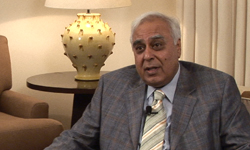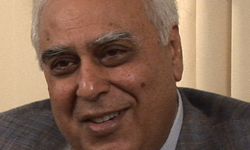Indian Science and Technology Minister Urges 'Simple, Affordable, Accessible' Technology Solutions
By Doug Ramsey, (858) 822-5825, dramsey@ucsd.edu
|
San Diego, CA, June 10, 2006 -- The Hon. Kapil Sibal, Union Minister of Science & Technology and Ocean Development, left San Diego in early June after spending several days at Calit2 and attending the U.S.-India Summit on Education, Research & Technology. The one-day event brought together a distinguished audience of government officials, university faculty, corporate leaders and student delegates to discuss how to improve collaboration between the two countries in education and research. The Summit was organized by the UCSD Division of Calit2. Before leaving California, Minister Sibal sat down with Calit2's Doug Ramsey for an interview to air on UCSD-TV later this summer. Following are excerpts from that conversation:
Q: How does the Indian government fund science and technology for the public good?
A: Previously the Government of India put in a lot of money but only into its autonomous institutions within the public sector. But now our policies are to fund the private sector, especially medium- and small-scale industry.
Q. Does your ministry play a role in targeting which sectors have the highest potential yield for India?
A. Yes. This cannot be a hit-and-run venture. You have to make sure what the strengths of India are in the context of the future of the world economy. Where will we and our entrepreneurs grow? Our growth areas are agriculture, agro-based industries, automobiles, textiles, pharmaceuticals, biotechnology, information technology, and the leather industry. These are potential growth sectors. We want to help entrepreneurs to start building products that are globally competitive so it results in the growth of Indian companies that are global competitors. We are also willing to fund foreign entrepreneurs who come to India as long as they partner with local companies. Or, they can use their own funds, because a lot of sectors are now 100% open to foreign direct investment, for example the agricultural sector.
Q. Why the focus on agriculture?
A. Because 600 million people are in agriculture. 60% are marginal farmers. We cannot have economic growth without equity; they must go hand in hand. There is no point for one or ten percent of the population, or 300 million in the middle class, growing very fast while 700 million other people are kept out of the loop. They must also get the benefit of growth. Which area has the largest potential? Agriculture, because it will generate a lot of employment. We need to invest where the agriculture is. Then they can do value addition to their products, putting more money into their hands so they can buy consumer goods, and fuel the economy to achieve the double-digit growth rate we are talking about.
|
A. Let me give you the example of leather, an industry that is under the Ministry of Trade and Commerce. Nevertheless, we turned around the entire leather industry because of technology. Leather was the most polluting industry in India because of the use of toxins for processing leather. We gave them technologies that were bio-friendly and today India is the leader in bio-friendly technologies for leather. As a result, people abroad looked at bio-friendly leather products, the quality is exceptionally good, so we have a niche in a world market that is $1 billion today, and by 2010 it will go up to $8 or $10 billion. So that's what we did. Our ministry was not involved with the trade and commerce ministry, but it was involved in evolving technologies to help the leather industry become globally competitive. So I can intervene at the technology end to help agriculture become more productive, increase the overall level of productivity in the Indian economy, and thereby help the man on the street.
Q. Helping rural India is a huge task, isn't it? Where do you begin the process?
A. First we must build rural infrastructure to link villages, ensuring that there is a communications system available for marketing products. We need linkages in terms of roads, electricity, water. These are primary needs. We need large cold storages that allow produce to be stored. But we cannot take off-the-shelf technologies that are available in the West and just put them to use in India, for the simple reason that they are both unaffordable and inaccessible to the poor. We need simple, affordable, accessible solutions.
Q. Can you give us an example?
A. Take the example of drinking water. Reverse osmosis is not a procedure that can be used in India because many places in India do not have power. So what we need are simpler technologies. One of the things we are doing now is to convert sea water into drinking water not by reverse osmosis, but by using the temperature differential between the surface water and the water 200 meters below the surface. Using flash evaporation and condensation of water, we can have clean drinking water at a cost which is very, very cheap compared to reverse osmosis. Here is a technology that is homegrown, accessible, affordable and which the Indian public will embrace. That's where we want to collaborate with Calit2 and the whole University of California structure, with academics and engineers, to find which challenges are facing the common people of India, and how we can meet those challenges with technologies that are affordable and accessible.
|
A. Our liberalization process started in 1990 and '91. China started in '78 so they are thirteen years ahead of us. At this point we are beginning to change our R&D structures and the way we think and do research. We believe the university system must be empowered, and students and researchers given autonomy and freedom to do the kind of things that Calit2 has so successfully done -- to the great advantage of people in the United States. This is why the U.S. is the number-one innovation center of the world and will remain so for a long period of time. So structurally we are trying to change our system. Hopefully soon I will introduce in India something like the U.S. Bayh-Dole Act of 1980. It will give the incentives that are necessary for academics to have a stake and ownership in the R&D they do and the creation of intellectual property. In addition we need to change our banking system and to have the banking system lend on a priority basis for R&D in academic institutions.
Q. President Kalam has laid out an ambitious goal for the country by the year 2020. How do you take that vision and translate it into science and technology policies?
A. Quite frankly, the President of India is a beacon of light for us. He has the vision of making India a developed country by 2020 and laid that vision before the people of India right after becoming president. It is our duty as a nation to give our people what they deserve and they deserve a better life. We need to implement this vision by using connectivity at all levels, from the physical level to the knowledge level. So we need a 'knowledge grid' where people can talk to each other, share ideas and work together without traveling long distances. At the same time the physical infrastructure is absolutely important to ensure that rural areas are connected to each other, and to the urban areas. I think that's the vision of the president. And our Prime Minister and our Government in their own way are attempting to realize that vision through huge and massive investments in infrastructure. We need $150 billion by 2015 to develop the kind of infrastructure that is needed -- port systems, highways, modern airports, telecommunications links. At the moment if you include our fixed lines and cellular phones, phone penetration is only 11%. In other words, 900 million people are out of the telecom link. So that also tells you of the enormous market that is waiting to be used and to be exploited. Our information systems will be such that we'll be able to put relevant and significant information within reach of ordinary folks so they can make informed decisions in rural areas. These are huge challenges and also an enormous opportunity to bring development to our people. That's the President's dream, that's our dream in the Ministry of Science and Technology, and we'll work towards it.
|
A. Let me tell you something about Indian democracy. By and large our people are exceptionally tolerant because they realize that no government can transform India overnight. The constituency I belong to is perhaps the most multicultural, multilinguistic, multiracial constituency in the world. On one street you have a Hindu temple, a Gudwara for the Sikh community, a mosque, and a Jain temple. Even when there are terrorist attacks (and there was one recently in my district), the whole community got together to work with each other and there is never tension there. The people in my community know I am there to work for them, to do my best for them, and I have in the last couple of years acquitted myself and gained their confidence, so I'm very proud of that today. They know I'm tackling basic issues for them like electricity and water; I have ensured that there will be a second reservoir for water - for the first time in 50 years. But the problems are so complex that I cannot reach everyone in my constituency, and these problems cannot be solved overnight. But in the next ten years I will make sure that Chandni Chowk will be a transformed place.
Q. You have spent most of this week at Calit2. What are your impressions of the institute, UCSD, and Southern California?
A. As far as I am concerned it's a dream come true. I've come to northern California many times, but never southern California. I think I've struck a chord in Calit2 and there are some absolutely fabulous people who have a world view, people who embrace what civilization should mean to the rest of the world. These are people who are cerebral and at the same time intensely humane. This great combination of intellect and humanity is symptomatic of this university and I consider it an honor to be here and to interact with some of the faculty members and R&D people here. I think this is going to be a fruitful and long-term relationship at a level which has perhaps not been seen before between any ministry and an institution outside of India.
Q. Have you been struck by the number of faculty and students of Indian origin who made time to attend the U.S.-India Summit at Calit2?
A. Given an environment in which the individual can reflect and realize his own genius, Indians going abroad can do exceptionally well. If they can do well outside of India, and if you give them the same environment inside India, they can also do well there, and we are ready to make that environment available to them. But it also shows that, much as they have embraced a country in which they were not born -- and they are giving their best to that country -- at the same time they are willing to extend themselves to reach out to where they came from. And that's wonderful.
Related Links
Department of Science & Technology
U.S.-India Summit on Education, Research & Technology
Related Articles
Streaming Video of U.S.-India Summit Proceedings Now Available On-Demand
Indian Science and Technology Minister Visits UC San Diego for High-Tech Talks with Calit2





